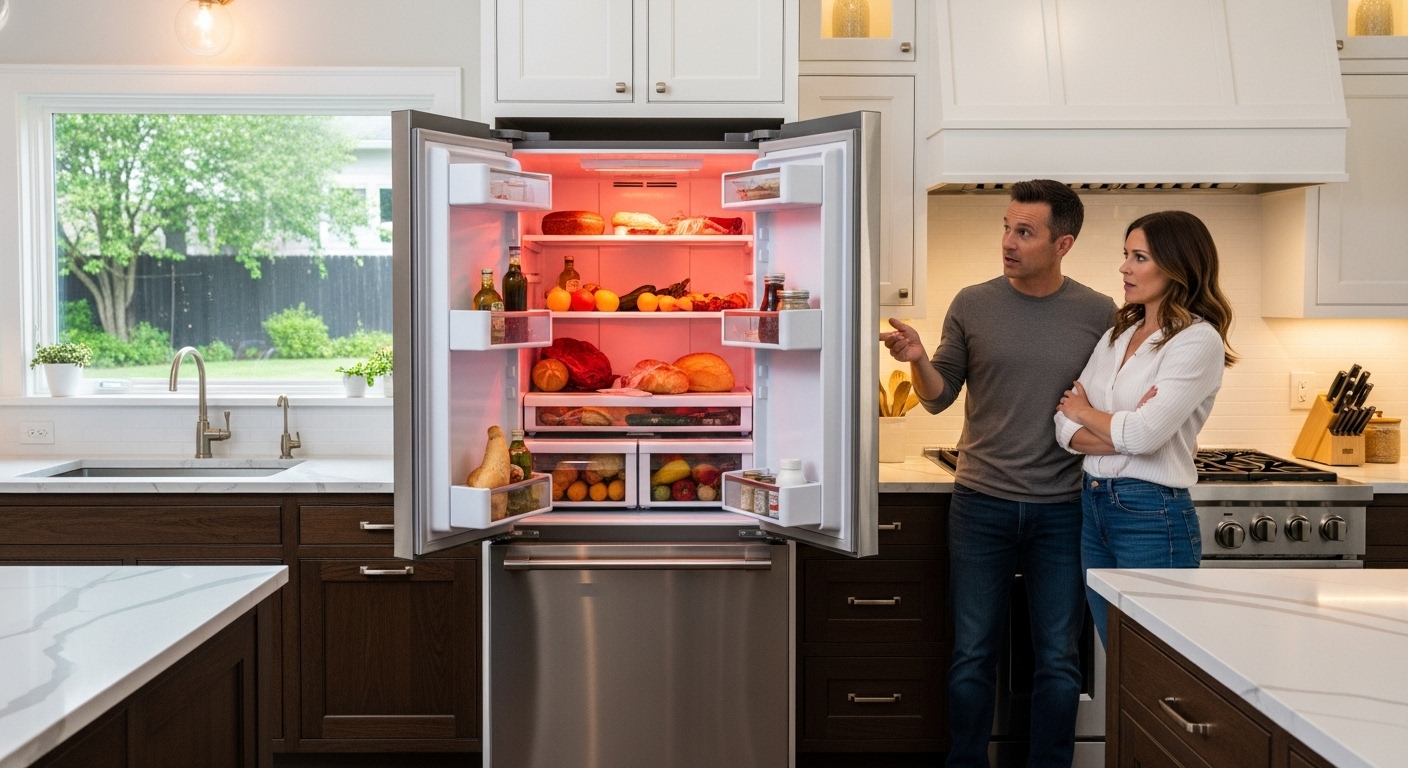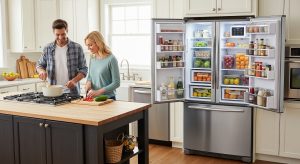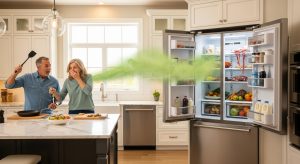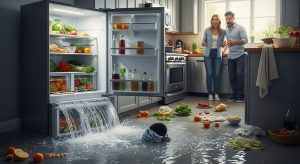Troubleshooting and Solutions
Few household problems are more immediately concerning than a refrigerator that isn’t keeping food cold enough. Whether you’ve noticed lukewarm milk, partially thawed frozen items, or condensation forming on food packages, a warm refrigerator threatens food safety, wastes money, and can signal potentially serious appliance issues. Understanding why your refrigerator isn’t maintaining proper temperature and knowing how to fix it can save you from food spoilage and costly repair bills.
Understanding Proper Refrigerator Temperature
Before troubleshooting, it’s important to know what temperature your refrigerator should maintain. The ideal refrigerator temperature is between 37°F and 40°F (3°C to 4°C), while the freezer should be at 0°F (-18°C). Temperatures above 40°F in the refrigerator compartment allow bacteria to multiply rapidly, potentially causing foodborne illness.
Use an appliance thermometer to check the actual temperature rather than relying solely on your refrigerator’s built-in display, which may not always be accurate. Place the thermometer in a glass of water in the center of the refrigerator and leave it for several hours or overnight for the most accurate reading.
Common Causes and Solutions
Thermostat Settings
Start with the simplest explanation—someone may have accidentally adjusted the temperature control. Check your thermostat settings and ensure they’re set to the manufacturer’s recommended position. If you’ve recently adjusted the setting, give the refrigerator 24 hours to reach the new temperature before making further changes.
Some refrigerators have separate controls for the fresh food compartment and freezer. Make sure both are set correctly. If you have a newer model with digital controls, ensure the display is showing the correct temperature settings and hasn’t been inadvertently changed.
Door Seal Problems
Damaged, dirty, or worn door gaskets are among the most common causes of insufficient cooling. When seals don’t close properly, warm air continuously enters the refrigerator, forcing it to work harder while never quite reaching the proper temperature.
Inspect the rubber seals around all doors carefully. Look for cracks, tears, gaps, or areas where the seal has pulled away from the door. Clean the seals thoroughly with warm, soapy water—food particles and sticky residue can prevent proper sealing.
Perform the dollar bill test: close the door on a dollar bill so half is inside and half is outside. If you can pull the bill out easily without resistance, the seal isn’t tight enough. Repeat this test around the entire perimeter of each door. If seals are damaged or failing the test, they need replacement.
Sometimes door seals that have become flattened or deformed can be rejuvenated. Try applying a thin layer of petroleum jelly to the seal to restore pliability, or use a hair dryer on low heat to gently warm and reshape the gasket.
Blocked Air Vents
Refrigerators rely on air circulation to maintain even temperatures throughout. Air vents inside the refrigerator and freezer compartments allow cold air to flow where it’s needed. If these vents are blocked by food items, containers, or ice buildup, cooling becomes inefficient.
Locate the air vents in your refrigerator—they’re typically found on the back wall of the fresh food compartment and in various locations in the freezer. Ensure nothing is blocking these vents. Rearrange food items to allow at least two inches of clearance around all vents.
In the freezer, check for excessive ice buildup around vents, which can restrict air flow. If you find significant ice accumulation, this could indicate a defrost system problem that needs professional attention.
Overfilled or Underfilled Refrigerator
Both extremes can cause cooling problems. An overpacked refrigerator restricts air circulation, preventing cold air from reaching all areas. Items stacked too tightly don’t have space for air to flow around them, creating warm spots.
Conversely, an extremely empty refrigerator can also struggle to maintain temperature. The stored items help retain cold and minimize temperature fluctuations when the door opens. As a general rule, keep your refrigerator about three-quarters full for optimal efficiency.
If you’ve recently purchased a large quantity of warm groceries or placed several hot items in the refrigerator, this can temporarily raise the internal temperature. Give the refrigerator 24 hours to recover before assuming there’s a mechanical problem.
Dirty Condenser Coils
The condenser coils release heat extracted from inside the refrigerator. When these coils become caked with dust, pet hair, and debris, they can’t efficiently release heat, causing the entire cooling system to struggle.
Locate your condenser coils—they’re typically on the back of the unit or underneath behind the front grille. Unplug the refrigerator before cleaning. For rear-mounted coils, carefully pull the refrigerator away from the wall. Use a coil brush or vacuum with a brush attachment to remove all dust and debris.
For coils underneath the refrigerator, remove the front grille and use a coil brush to clean thoroughly. This location tends to accumulate more dirt and pet hair. Clean coils can dramatically improve cooling efficiency and should be cleaned every three to six months.
Faulty Door Closure
Even with good seals, doors that don’t close properly allow warm air to enter constantly. Check that doors close fully and stay closed on their own. A properly adjusted refrigerator door should swing closed gently when opened about halfway.
Inspect the door hinges for looseness or damage. Tighten any loose screws on the hinges. Check if something is preventing the door from closing completely—a protruding food item, overstuffed door bins, or a shelf that’s been pushed back too far.
Ensure your refrigerator is level. Use a level placed on top of the refrigerator to check. An unlevel refrigerator may have doors that swing open instead of closed. Adjust the leveling feet at the bottom corners of the refrigerator to achieve proper leveling. The front should be slightly higher than the back to encourage doors to close on their own.
Evaporator Fan Issues
The evaporator fan circulates cold air from the freezer throughout the refrigerator. If this fan isn’t working properly, the freezer may stay cold while the fresh food compartment warms up.
Listen for the fan running when the refrigerator is operating—you should hear air movement and a gentle humming from the fan motor. Open the refrigerator door; on most models, the fan should stop when the door opens and resume when it closes.
The evaporator fan is typically located behind a panel in the freezer compartment. If you don’t hear it running or if you hear unusual noises like grinding or squealing, the fan or motor may need replacement. This repair typically requires a professional technician.
Condenser Fan Problems
Refrigerators with coils underneath or on the back have a condenser fan that helps cool the coils and compressor. If this fan fails, cooling efficiency drops significantly.
With the refrigerator plugged in, listen near the bottom back of the unit. You should hear a fan running when the compressor is operating. If the compressor is running but you don’t hear a fan, the condenser fan may have failed.
Unplug the refrigerator and access the condenser fan (usually from the back or by removing the lower rear panel). Check if the fan blade spins freely by hand. If it’s stiff, obstructed by debris, or doesn’t spin at all, it may need cleaning or replacement.
Defrost System Failure
Automatic defrost systems prevent ice buildup on the evaporator coils. When this system fails, ice accumulates and blocks air flow, reducing cooling capacity. This is particularly common in the freezer compartment.
Check for excessive frost or ice buildup in the freezer, especially around the back wall or evaporator fan area. A thin layer of frost is normal, but thick ice coating or solid ice blocks indicate a defrost problem.
Defrost system failures can involve the defrost timer, defrost heater, or defrost thermostat. Diagnosing which component has failed typically requires professional expertise, though manually defrosting the refrigerator (by unplugging it and letting all ice melt) can temporarily restore cooling.
Compressor Issues
The compressor is the heart of your refrigerator’s cooling system, pumping refrigerant through the coils. Compressor problems are serious and often expensive to repair.
Listen for the compressor running—it produces a low humming sound from the bottom back area of the refrigerator. The compressor should cycle on and off throughout the day. If it’s running constantly without the refrigerator cooling, or if it’s not running at all despite the refrigerator being plugged in and set correctly, there may be a compressor issue.
A compressor that feels extremely hot to the touch may be struggling or failing. Some warmth is normal, but excessive heat indicates problems. If you hear clicking sounds as the compressor tries to start but fails, this suggests electrical or mechanical issues with the compressor.
Compressor repairs are costly—often $500 to $1,000 including labor—and may not be worth it for older refrigerators. If your refrigerator is more than 10-12 years old and the compressor has failed, replacement might be more economical.
Refrigerant Leaks
Refrigerant is the substance that actually removes heat from inside your refrigerator. If there’s a leak in the sealed system, refrigerant escapes and cooling diminishes progressively over time.
Signs of refrigerant leaks include gradually declining cooling performance over weeks or months, the refrigerator running constantly without achieving proper temperature, frost or ice forming in unusual places, and an oily residue around the compressor or coils.
Refrigerant leaks require professional repair. The leak must be found and sealed, then the system must be evacuated and recharged with the correct amount and type of refrigerant. This is not a DIY repair and requires specialized equipment and EPA certification.
Failed Start Relay or Overload
The start relay and overload protector help the compressor start and protect it from overheating. When these components fail, the compressor won’t run, even though other parts of the refrigerator may still have power.
If you hear clicking sounds from the back of the refrigerator but the compressor doesn’t start, or if the compressor runs briefly then shuts off repeatedly, the start relay or overload may have failed.
These components are relatively inexpensive and can be replaced by a handy homeowner, though many people prefer professional service. They’re located near the compressor at the back bottom of the refrigerator.
Environmental Factors
Sometimes the problem isn’t with the refrigerator itself but with its environment. If your refrigerator is located in a very hot space like a garage in summer, it may struggle to maintain proper temperature, especially if it’s not designed for such conditions.
Ensure the refrigerator has adequate clearance for air circulation—at least two inches from the wall and away from heat sources like ovens, dishwashers, or direct sunlight. Poor ventilation forces the refrigerator to work harder and can prevent it from cooling adequately.
Check that the ambient temperature in the room isn’t too extreme. Most refrigerators are designed to operate in temperatures between 55°F and 90°F. Outside this range, cooling performance may suffer.
Recent Power Outages
If you’ve recently experienced a power outage, your refrigerator may simply need time to cool down again. After power is restored, it can take 4-24 hours for a refrigerator to return to proper temperature, depending on how long the power was out and how full the refrigerator was.
During this recovery period, minimize door openings to help the refrigerator cool faster. If power was out for more than four hours, check food items for signs of spoilage before consuming them.
Diagnosing the Problem Systematically
When your refrigerator isn’t cold enough, approach troubleshooting systematically. Start with the simplest, most common causes and work toward more complex issues. Check temperature settings first, then inspect door seals, clear any blocked vents, and clean the condenser coils.
Listen to your refrigerator and note any unusual sounds or behaviors—constant running, clicking without starting, loud noises, or complete silence when it should be running. These clues help identify the problem.
Feel the compressor at the back bottom of the unit. Some warmth is normal, but extreme heat or no warmth at all when it should be running indicates problems. Check if both the refrigerator and freezer are too warm, or just one compartment—this information helps narrow down the cause.
When to Call a Professional
Some refrigerator cooling problems are beyond DIY repair. Call a professional technician if the compressor won’t start or runs but doesn’t cool, if you suspect refrigerant leaks (especially if there’s an oily residue or unusual hissing sounds), or if there’s excessive ice buildup despite manual defrosting.
Electrical issues like blown fuses, tripped breakers that won’t reset, or burning smells require immediate professional attention. If you’ve checked all the common causes listed above and the refrigerator still isn’t cooling properly, professional diagnosis is warranted.
Emergency Food Safety Measures
While troubleshooting or waiting for repairs, protect your food from spoilage. Use coolers with ice to store perishable items like meat, dairy, and prepared foods. Keep the refrigerator door closed as much as possible to maintain whatever cooling remains.
A full freezer will keep food frozen for about 48 hours if the door stays closed; a half-full freezer for about 24 hours. The refrigerator compartment will keep food safely cold for about four hours if unopened.
Check food temperatures with a food thermometer. Discard any perishable food that’s been above 40°F for more than two hours. When in doubt, throw it out—the cost of discarded food is far less than the cost of foodborne illness.
Prevention for the Future
Once you’ve resolved the cooling problem, take steps to prevent recurrence. Clean condenser coils every three to six months, inspect door seals regularly and clean them monthly, and avoid overloading the refrigerator or blocking air vents.
Keep the refrigerator in a climate-controlled space away from heat sources, maintain proper clearance for air circulation, and schedule professional maintenance every few years for older refrigerators.
Set reminders to check the temperature periodically with an appliance thermometer to catch problems early before food safety becomes an issue.
The Bottom Line
A refrigerator that’s not cold enough demands immediate attention for both food safety and to prevent a minor issue from becoming a major repair. By systematically checking common causes—from simple thermostat adjustments to more complex mechanical issues—you can often identify and resolve the problem quickly.
Many cooling issues stem from simple maintenance problems like dirty coils, blocked vents, or worn door seals that homeowners can address themselves. However, don’t hesitate to call a professional for complex issues involving the compressor, refrigerant system, or electrical components.
Remember that your refrigerator works hard every day to protect your food and your family’s health. When it’s not performing properly, prompt action saves money, prevents food waste, and ensures your appliance continues serving you reliably for years to come.



